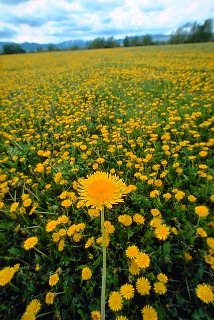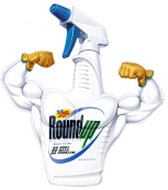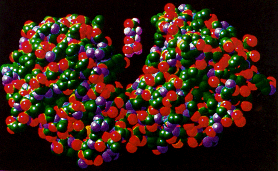

What is Biology Good For?
Killing Weeds: RoundUp
(This assignment is optional. Read this essay and answer the questions at the bottom for 3 extra credit points. It is not necessary to visit the links in the text unless you are interested in more information.)
Good For 1, Good For 2, Good For 3, Good For 4, Good For 5, Good For 6, Good For 7, Good For 8, Good For 9, Good For 10 (Genetics Quiz), Good For 11, Good For 12, Good For 13, Good For 14
It's that time of year
again...Spring! Fresh green grass,
daffodils, spring robins, and ..Taraxacum officinale...the
Common Dandelion. Although  dandelions
were first brought to this country as a colorful garden plant,
and are beloved by children, most adults consider T.
officinale to be an eyesore...a blight on an otherwise green
expanse of lawn...in short - a weed.
dandelions
were first brought to this country as a colorful garden plant,
and are beloved by children, most adults consider T.
officinale to be an eyesore...a blight on an otherwise green
expanse of lawn...in short - a weed.
(Does this sound like
YOU?)
"As adults we often lose sight of the many small things that
intrigued us in the spring of youth. The same children who
delighted in the little white balls just a decade ago, can now be
found in the lawn and garden stores, searching through containers
of deadly toxins for the perfect poison to irradicate what
previously had delighted them so." [Quote & Image]
((Do you still
love dandelions? The Dandelion Page, by Dr. Weed))
What is a Weed?
Generally, the term weed describes any plant that is unwanted and grows or
spreads aggressively. The term exotic weed
describes an invasive unwanted non-native plant. The term noxious weed is reserved for particularly aggresive weeds, usually
of agrinomical importance. (The USDA keeps a Federal list of noxious weeds.)
Weeds are very important agronomically because
they reduce the yield of crops in three ways: by
competing with the crop for water, light and nutrients, by
interfering with crop harvest, and by contaminating harvested
products with weed seeds and toxins. Weeds can reduce yield up to
50% and are responsible for millions of dollars
in crop losses each year. However, what is considered a weed in
one area may not be a weed in another. Closing Thought: A weed is no more than a flower
in disguise.[Quote]
Another sign of spring....For those of us who may appreciate the dandelion,
yet still want it out of our back (or front) yard:
RoundUp
 RoundUp
(or Glyphosate), one of the
world's most popular and 'friendly' herbicides, is a non-selective herbicide used
primarily for perennial weed control - in short, killing weeds.
Glyphosate was discovered by Dr. John E. Franz of Monsanto in 1971 and released commercially in
1974. Starting in 1983, and every year since, RoundUp became the
first pesticide with world-wide sales of over $1 billion. It is
known as a "postemergence" herbicide, meaning that is cannot
be used until after the weed species has sprouted, or 'emerged'. RoundUp
is an extremely effective herbicide, but it is also non-selective herbicide: it will kill almost all
species of plants, both wanted (crops, grass) and unwanted plants
(weeds). Therefore, Roundup can be used for spot weed control,
but not for general application on grass or crops, so users must
spray with caution!
RoundUp
(or Glyphosate), one of the
world's most popular and 'friendly' herbicides, is a non-selective herbicide used
primarily for perennial weed control - in short, killing weeds.
Glyphosate was discovered by Dr. John E. Franz of Monsanto in 1971 and released commercially in
1974. Starting in 1983, and every year since, RoundUp became the
first pesticide with world-wide sales of over $1 billion. It is
known as a "postemergence" herbicide, meaning that is cannot
be used until after the weed species has sprouted, or 'emerged'. RoundUp
is an extremely effective herbicide, but it is also non-selective herbicide: it will kill almost all
species of plants, both wanted (crops, grass) and unwanted plants
(weeds). Therefore, Roundup can be used for spot weed control,
but not for general application on grass or crops, so users must
spray with caution!
 RoundUp is considered a 'friendly'
herbicide to the environment because:
RoundUp is considered a 'friendly'
herbicide to the environment because:
- It is virtually nontoxic to mammals,
birds, fish, and insects
- It exhibits essentially no pre-emergence activity. It won't
prevent plants in your garden from germinating.
- It exhibits essentially no residual soil activity even when
applied at high rates. Roundup
binds tightly to soil particles and doesn't move on or in the
soil to affect untreated plants nearby.
- It breaks down quickly into natural materials such as carbon
dioxide and nitrogen.
- It does not penetrate the woody stems of trees, shrubs, or
grapevines
- Finally, the most important feature, once inside the plant,
glyphosate inhibits a key enzyme found only in plants and
bacteria – EPSP synthase. [Image]
How does RoundUp work?
RoundUp (glyphosate) inhibits a key enzyme that
plants and bacteria use to make amino acids called EPSP synthase. Structurally, glyphosate resembles
the chemical structure of the amino acid glycine.
Because of its structural similarity to glycine, glyphosate binds
the active site of the EPSP
synthase enzyme that is critical
for the production of aromatic amino acids.
 Without a functional EPSP synthase enzyme, the plant can no longer make
the amino acids phenylalanine, tyrosine and tryptophan or any other compounds that use this pathway. Since plants must
synthesize all of the amino acids that they need for protein
production, inhibition of EPSP synthase by glyphosate causes the
plant cells to starve for amino acids. All
plants and bacteria use EPSP synthase to make aromatic amino
acids, so all plants and bacteria are sensitive to RoundUp. [Image of EPSP Synthase]
Without a functional EPSP synthase enzyme, the plant can no longer make
the amino acids phenylalanine, tyrosine and tryptophan or any other compounds that use this pathway. Since plants must
synthesize all of the amino acids that they need for protein
production, inhibition of EPSP synthase by glyphosate causes the
plant cells to starve for amino acids. All
plants and bacteria use EPSP synthase to make aromatic amino
acids, so all plants and bacteria are sensitive to RoundUp. [Image of EPSP Synthase]
Glyphosate is quickly absorbed by leaves
and shoots of plants. Once absorbed into the leaves, glyphosate
cannot be broken down. The glyphosate moves quickly through the
plant and accumulates in areas of active growth called meristems.
Spraying a plant with RoundUp results in a lack of protein
synthesis in that plant. Without amino acids, Plants stop
growing. Within a week or so, many plant tissues and parts slowly
degrade due to lack of proteins. Death of the weed ultimately
results from lack of nutrients and dehydration a week or so
later.
Roundup does not affect mammals, birds, fish, and insects because these organisms do not have the enzyme EPSP synthase. However, a recent study has found an increased risk for Non-Hodgkin's Lymphoms (NHL), a type of leukemia, in agricultural workers exposed to large quantities of RoundUp.
Monsanto has developed a type of genetically engineered plant, called RoundUp Ready, that is genetically resistant to RoundUp. Over 70% of all soybeans grown in the USA are RoundUp Ready, and almost 50% of corn and cotton are RoundUp Ready. We will discuss this in detail on April 30 ~ the last day of class! [Image]
Material from this Good For came from the following
sources:
RoundUp.com
Monsanto: RoundUp Product Summary
Glyphosate: Herbicide, Enzyme Inhibitor
Frequently Asked Questons about RoundUp
Glyphosate, Advanced Topics
Glyphosate: The Friendly Herbicide - by Monsanto
Glyphosate: The Acutely Toxic Chemical Element - by Guarding our Earth.com
A final thought
from Dr. Marrs on the weed homeowners love to hate...
The Canada Thistle, Cirsium arvense (from the Latin: 'Cursed
Thistle')
From the Weed
Science Socety of America: "Canada
thistle, the best-known thistle species, is native to Europe or
temperate Asia. Immigrants brought C. arvense to America
in crop seed. It spread so rapidly that control legislation was
enacted in Vermont in 1795 and in New York in 1831 (8). It is a
noxious perennial weed that has invaded the whole northern half
of the United States.
An earlier common name for C. arvense was "cursed
thistle". Linnaeus in 1753 wrote of this plant, "It is
the greatest pest of our fields" (2). Its roots may
penetrate 20 feet deep, and the Canada thistle sends up countless
new shoots when its underground parts are broken and are spread
by tillage. One plant, propagating by its roots and rhizomes,
"can colonize and area several meters in diameter during the
first one or two seasons of growth" (5). It infests 27 crops
in 37 countries and is worst in temperate regions of the northern
hemisphere (5). It readily destroys pastures, as cattle dislike
and avoid it. The thistles are characterized by spiny stems,
alternate leaves, and terminal discoid flower heads set in spiny
bracts. The flower heads vary in color from creamy white to deep
purple and are from 1 to 2 inches across, consisting of compact,
tubular, perfect flowers that look like a shaving brush."
My Favorite Remedy for the Cursed Thistle:

Questions: 3 points extra credit. Click on the links for more information! One sentence should be enough to answer each question . Once you hit 'submit', you will receive a Thank You confirmation page.
Please type your Student ID
Number:
LAST name followed by
first initial or first name:
1. How does glyphosate kill plants?
2. Why doesn't glyphosate kill mammals, fish, insects or birds?
3. What does the name Dandelion
mean? (See Dr. Weed's section on "What is a Weed?")
You may change your mind as
often as you wish. When you are satisfied with your responses
click the SUBMIT button. You will receive a "THANK YOU"
page as a confirmation that your response has been sent to me.
****************************************************************